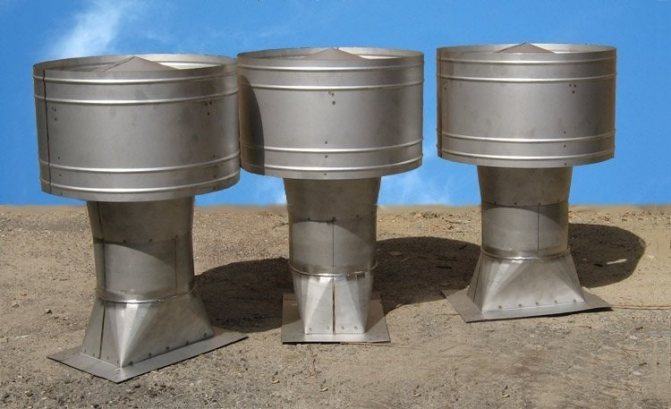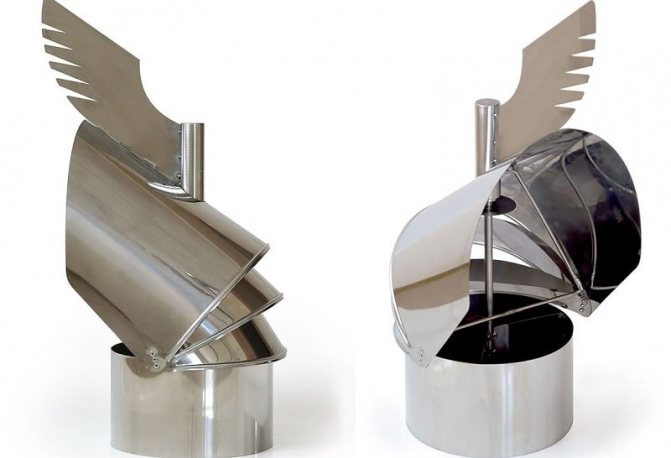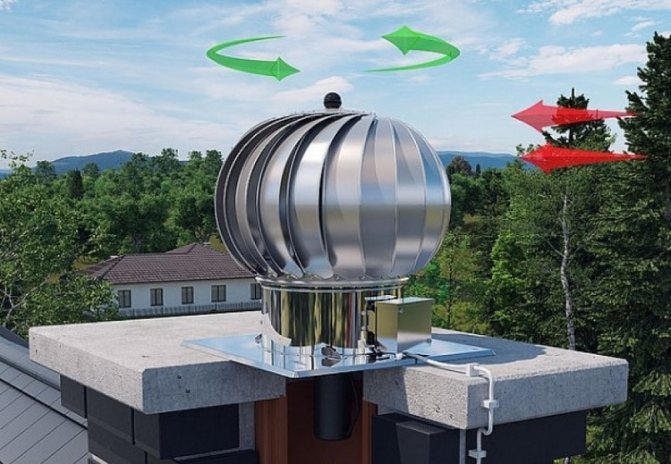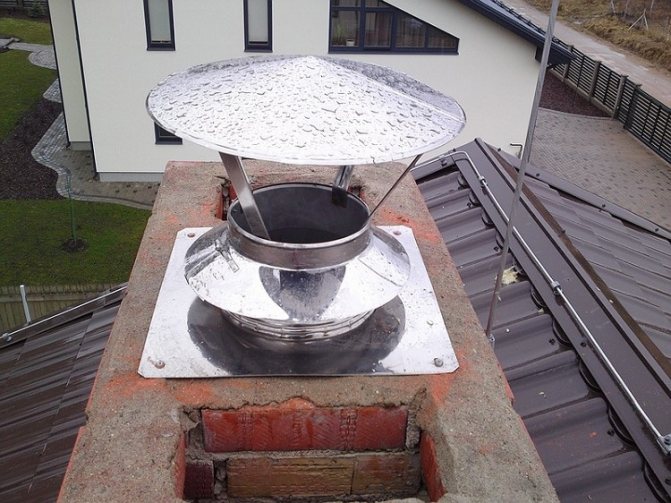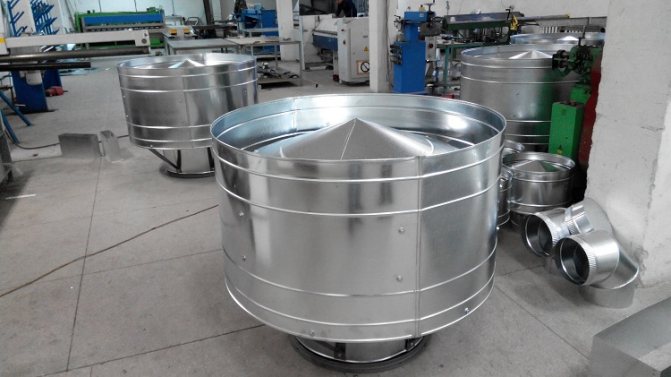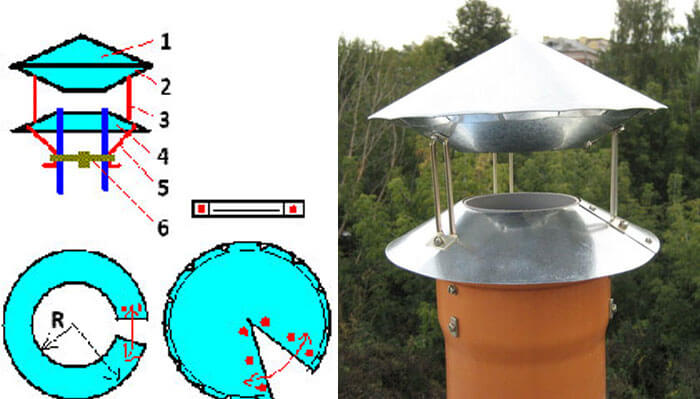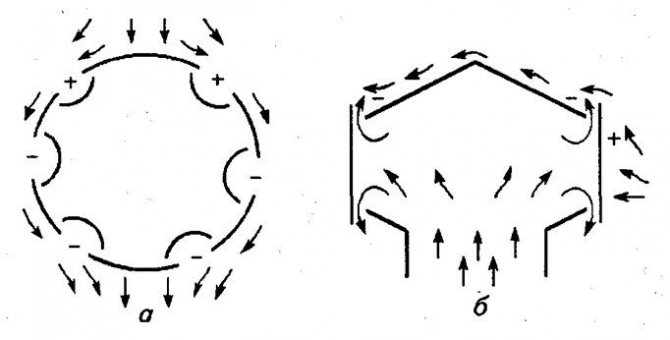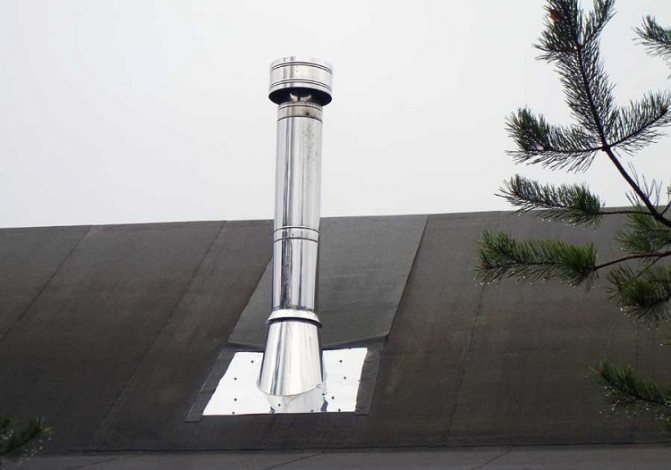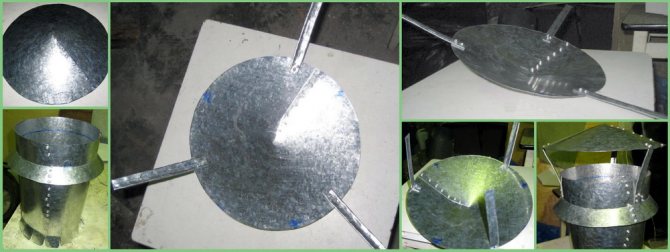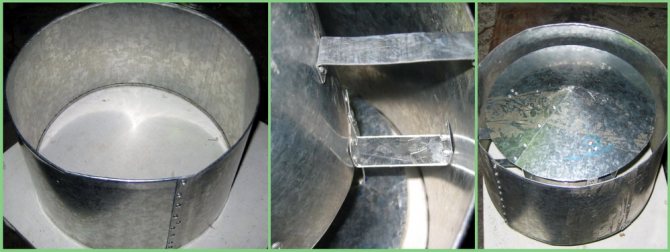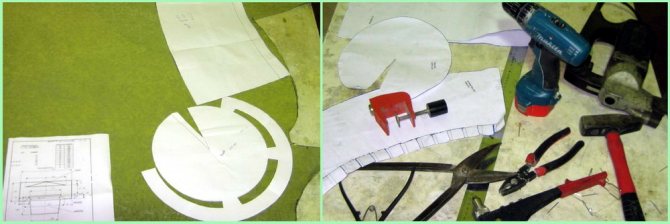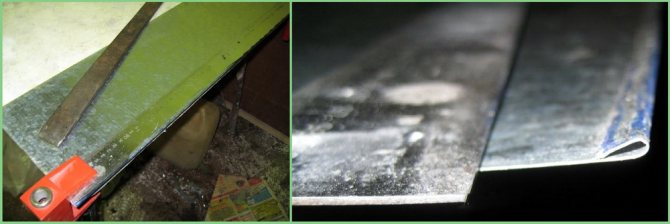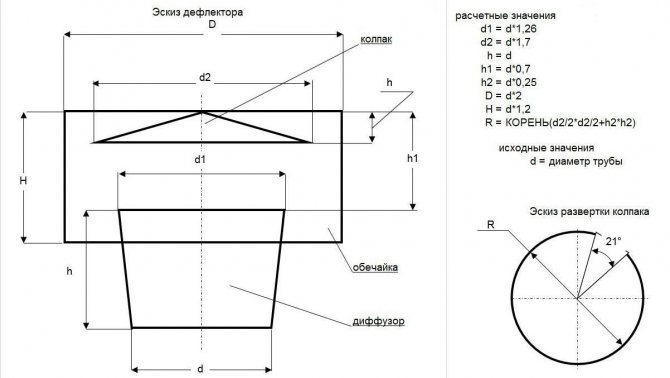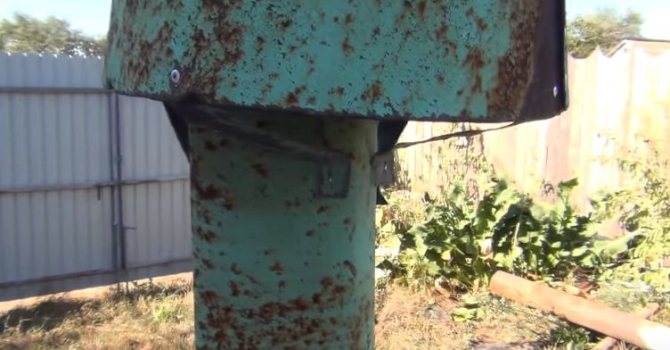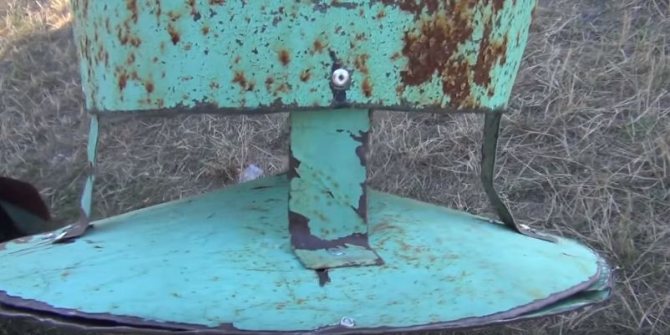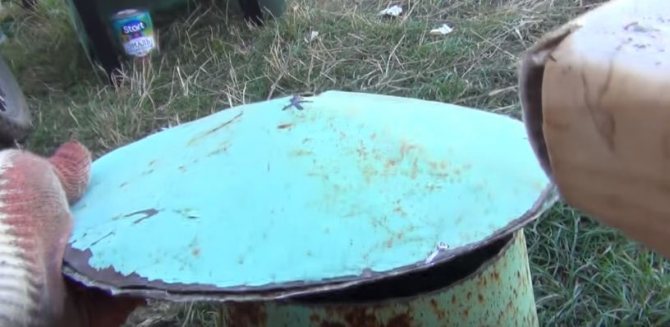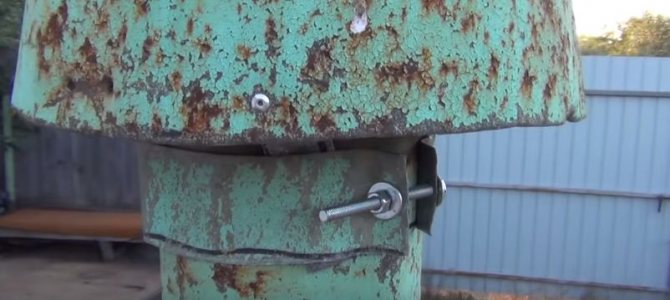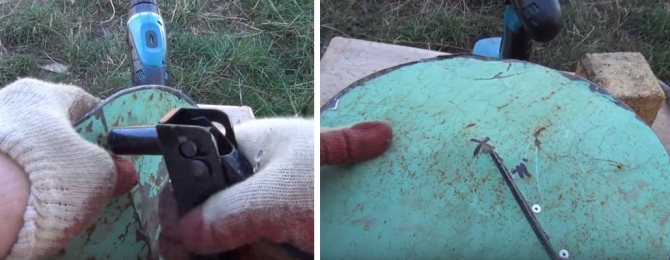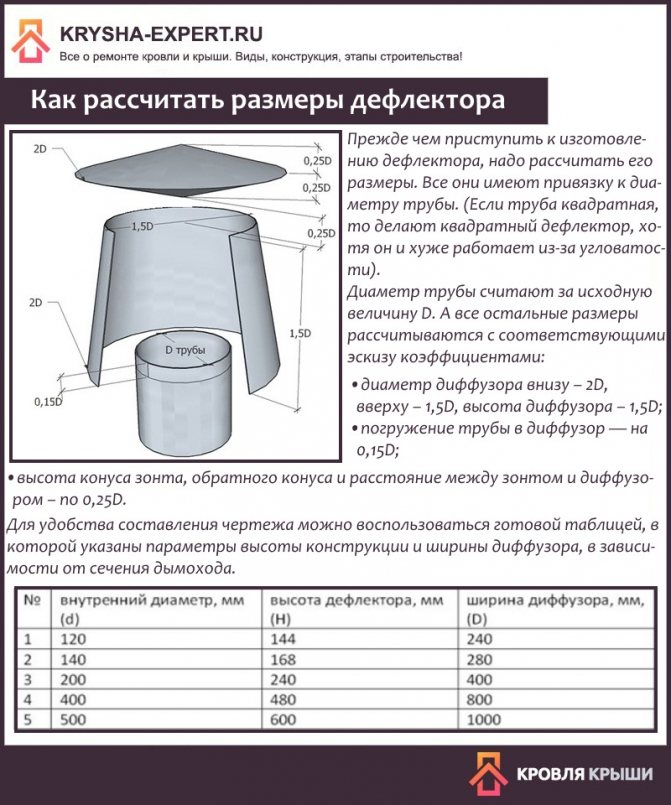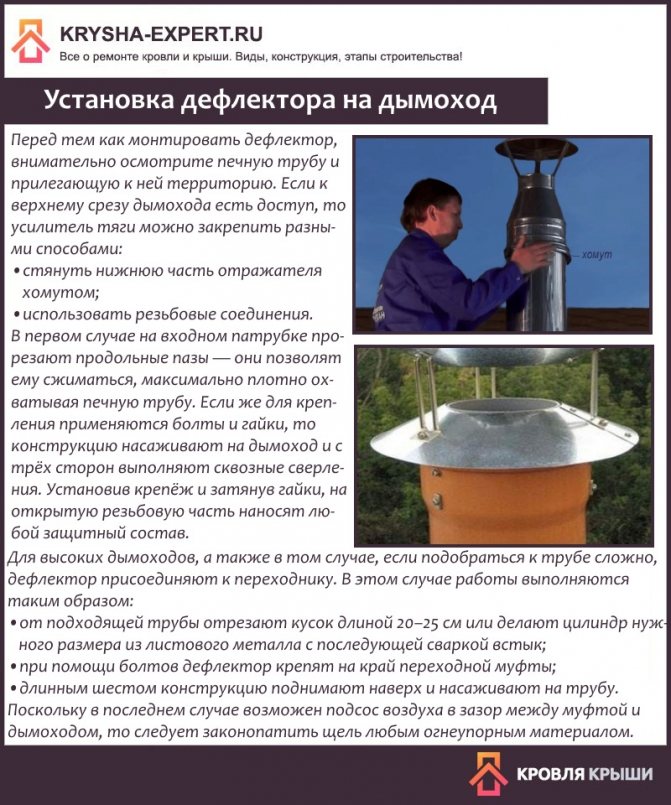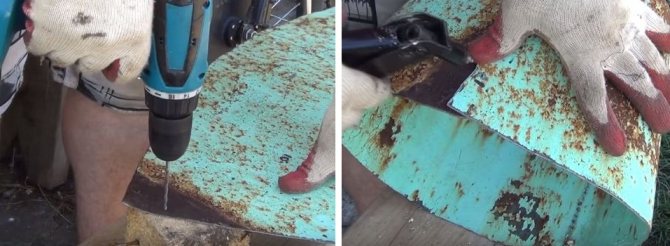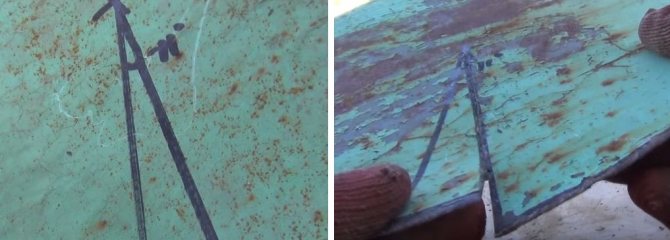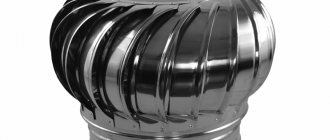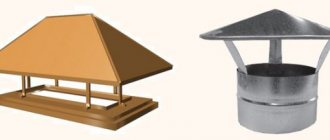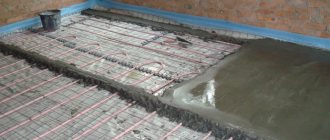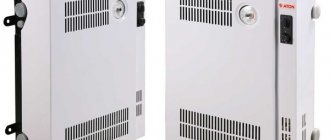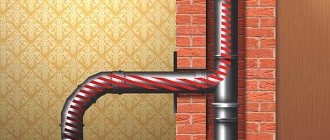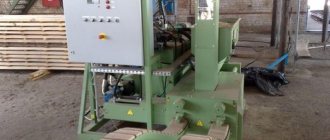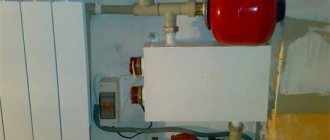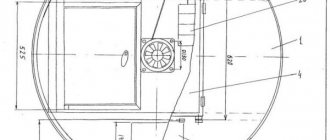The chimney deflector is a simple cone-shaped design that covers the chimney on the roof of the house. Such a device creates good draft inside the chimney, prevents it from contamination and protects from precipitation and gusts of wind.
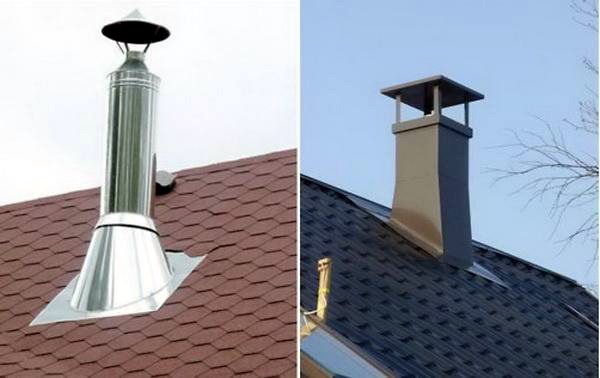
Many owners of private houses do not know how to increase the efficiency of a chimney with a cone or weather vane, and some even install this structure for aesthetic purposes. In this material, we will try to figure out what is the principle of operation of the deflector and which models are most applicable in everyday life.
Purpose
So, the tsagi deflector is designed to increase the draft of the chimney or ventilation system. Its principle of operation is as follows: it is known from the laws of physics that warmer air is lighter than cold air. If the air heats up from below, then unheated air begins to press on it from above, since its mass is greater, respectively, the warm flow rises up. The usual chimney system is based on this, that is, smoke, like more heated air, rises up by gravity. However, it is hindered by colder air, since the chimney is a closed system. So, in order to reduce this pressure of cold air, that is, to reduce the resistance, a deflector is installed that cuts the air flow, thereby establishing a low pressure area (vacuum area) above the chimney or ventilation pipe. This naturally increases cravings.
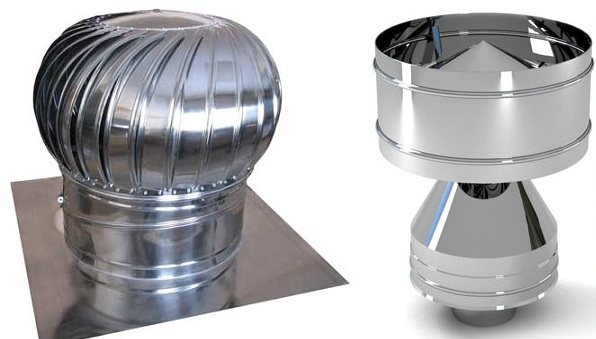

Deflector tsagi
Strengthening the draft contributes to the fact that the efficiency of the device that underlies, for example, if we are considering a chimney, then it may be a stove, increases by 20 percent. This means that the combustion process will be much better without the use of additional amounts of combustible substances.
From all this, we can conclude that the tsagi deflector is intended only to increase thrust. However, there is a special group of such devices. These are rotary products. Their essence lies in the fact that the central part rotates, which creates an even greater rarefaction of the air around, respectively, and the thrust increases.
Such deflectors also serve for forced ventilation, removal of gases and vapors from the room.
Product design
If you plan to make a tsagi deflector with your own hands, then it will not be superfluous to consider its design, that is, to install all the individual parts of which it consists:
- Lower cylinder or branch pipe. It will be attached to the end of the ventilation system duct or the end of the chimney pipe;
- Diffuser. This part is represented by a widened cone that goes from the nozzle to the top of the product;
- Branch pipe or shell. This is the outside of the device;
- Cap or top cone. The part that is attached to the top of the entire structure and protects the ventilation or chimney systems from precipitation;
- Legs for attaching the cap;
- Brackets for attaching the entire device.
Tsagi deflector circuit
It must be said right away that all these elements are made by hand from galvanized sheet or stainless steel. These materials can be found in sheet form at all hardware stores.
Device and types of deflectors
Despite the existence of many models of deflectors, they are basically built using the following structural elements:
- inlet pipe with nipple or flange connection;
- an outer cylinder called a diffuser;
- hulls;
- a cone-shaped cap called an umbrella;
- brackets for attaching an umbrella.
In some designs of deflectors, two cones can be used - direct and reverse. The first serves as protection against precipitation, and the second serves to redistribute the flow of combustion products.
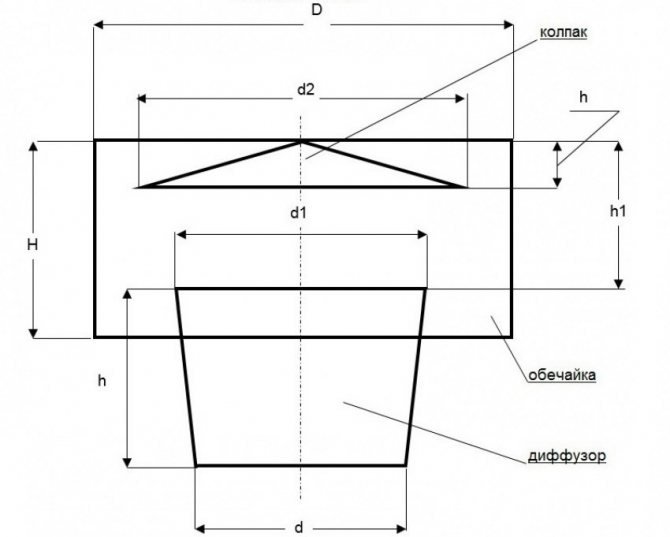

Different deflectors share common structural elements
For making deflectors with your own hands, sheet galvanized or stainless steel is best suited. In addition to these materials, the industry has mastered the production of devices with a protective enamel layer or a heat-resistant plastic coating.
Among the many deflectors that can be made by hand, there are several of the most popular designs.
Deflector TsAGI
The TsAGI deflector is a universal device that can be installed on any pipe - stove, exhaust or ventilation. Developed at the Central Aerohydrodynamic Institute. Zhukovsky device has a simple design with an open flow path and reverse draft protection. There are two types of TsAGI reflectors designed for external or internal installation. Due to its multiple advantages, this type of deflector has gained wide popularity among DIYers. However, the design is not without its drawbacks. The “weak link” is the narrow flow area, which can be overlapped by a layer of ice on the inner cylinder. In addition, the TsAGI deflector is not effective enough in light wind and calm - in these conditions, its design creates little resistance to natural draft.
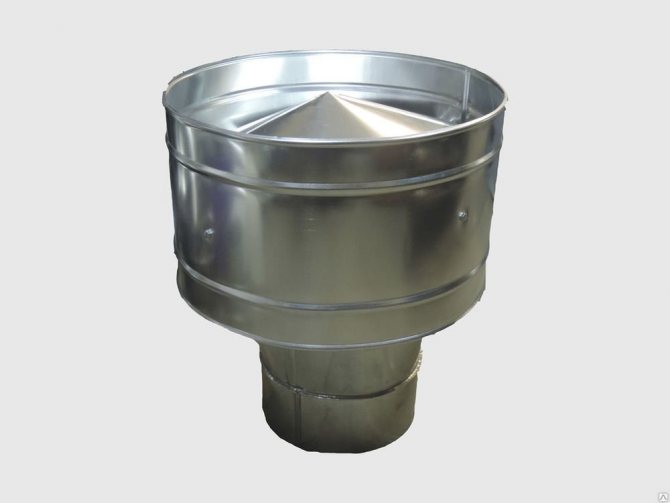

TsAGI Delector features a simple design and excellent performance
Poppet
This deflector got its name because of several cones (plates) in its composition and refers to devices with an open flow path. The reflector has a protective umbrella combined with a cone and a lower part in the form of a hood with a hole for smoke outlet. Vacuum occurs due to the plates directed towards each other, which form a narrowing channel for the incoming air currents.
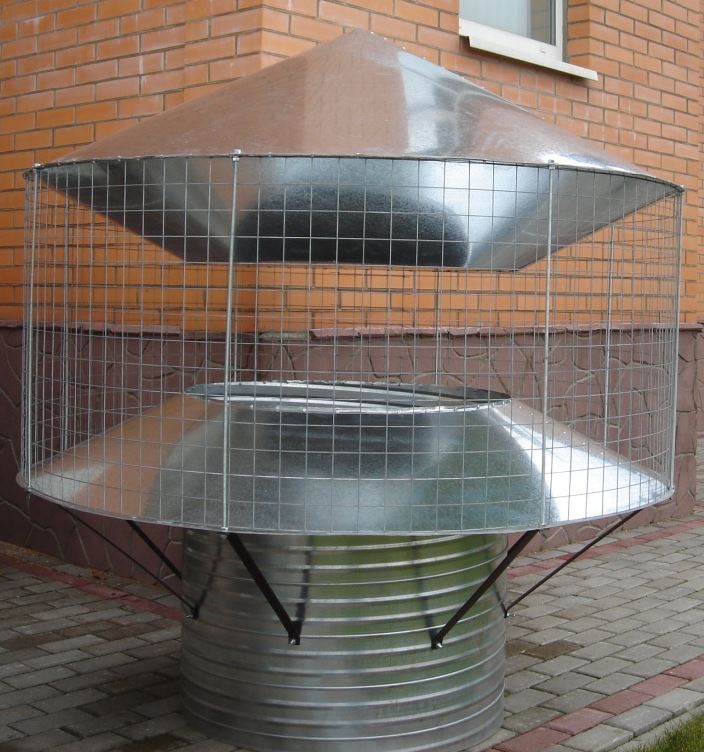

In a dish-shaped deflector, a vacuum occurs in the gap between the cones directed towards each other
Round "Volper"
The device has a design similar to the TsAGI reflector. The differences concern only the upper part of the deflector. The hood, which protects the inside of the chimney from debris and precipitation, is installed over the diffuser, which eliminates some of the shortcomings of the device developed at TsAGI. Zhukovsky.
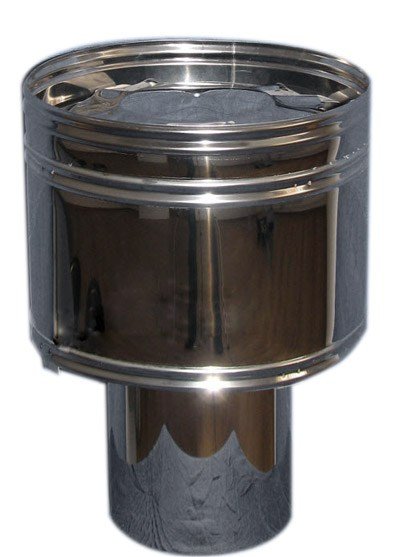

"Volper" has minimal differences from the TsAGI traction amplifier, which provide it with advantages in the absence of wind
Deflector Grigorovich
One of the more repeatable designs is the TsAGI Advanced Deflector. The smoke that comes from the chimney passes through the tapering channel of the diffuser, thereby increasing the speed of its outflow. The Grigorovich deflector is best suited for chimneys installed in lowlands and in areas with weak air flow, since it is able to provide good draft even in complete calm.
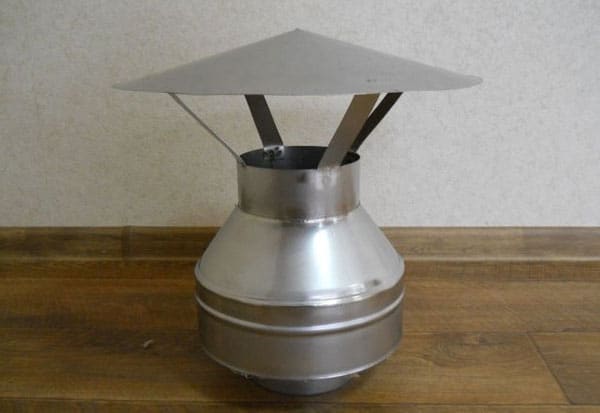

Grigorovich deflector - ideal solution for areas with weak air currents
H-shaped
Deflectors, the silhouette of which resembles the letter "H", are designed to equip chimneys of powerful furnaces and boiler installations. In such devices, the exhaust gas stream is split into two parts and exits with acceleration through two side diffusers. The advantages of the design consist in a significant improvement in traction when air masses move in any direction. In addition, the H-shaped deflector does not require the installation of a visor, since the chimney mouth is protected by the transverse pipe of the device.
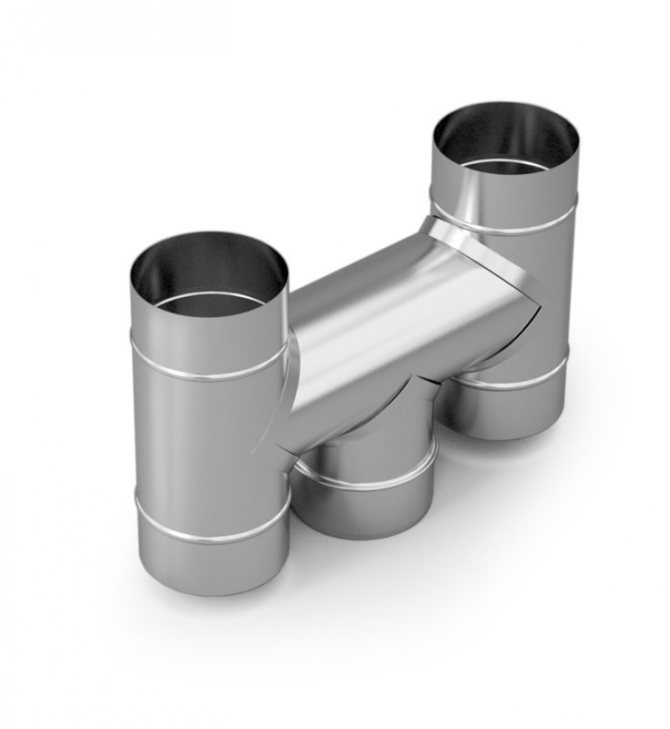

H-shaped traction amplifiers are designed for installation on chimneys of powerful heating units
Rotating
The device is made in the form of a sphere with many curved side blades. The presence of blades allows the device to rotate in a certain direction and work like a turbine. Rotary deflectors are best suited for gas boilers and do an excellent job of protecting the chimney from debris and precipitation. The disadvantages of devices of this type are their low efficiency with icing and no wind.
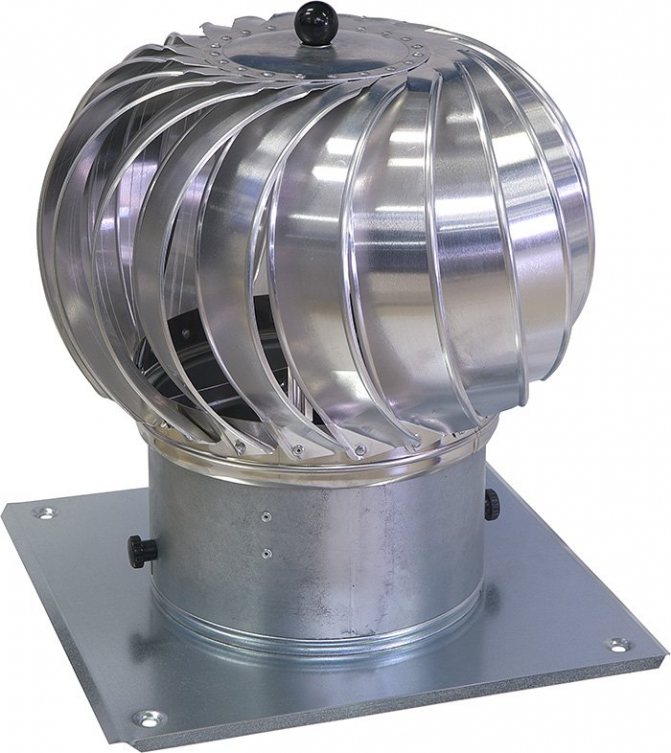

Multiple blades of a rotating deflector create thrust like a turbine
Deflector-weather vane
Such a reflector has a rotating part (vane), which turns when the wind direction changes. In this case, the curtain of the deflector obscures the chimney from the incoming air masses and contributes to the appearance of a vacuum from the leeward side. Thanks to this, an active suction of combustion products is carried out, which excludes back draft and the formation of sparks.
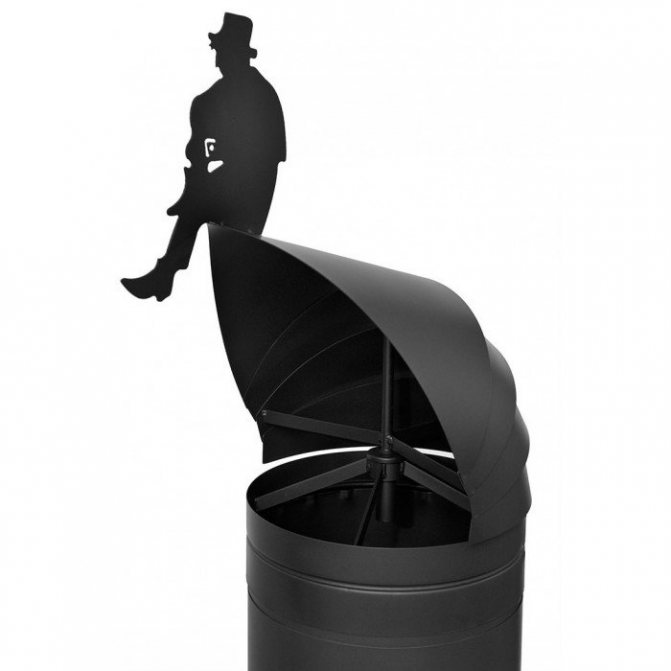

The deflector with a weather vane can be rotated, orienting the reflector exactly across the direction of the wind
Self-production
So, in order to make a tsagi deflector with your own hands, you must calculate it in advance. To do this, you should know some of the technical characteristics that such devices may have:
- Deflector shape;
- Manufacturing material;
- Deflector dimensions;
- His type.
Since we have decided on the type - this is the device of the tsagi of the design described above, it remains to decide on all the other parameters of the future self-made deflector.
So, the calculation begins with the establishment of the desired form. Everything is simple here. The shape of the deflector directly depends on the shape of the pipe on which it is made. Next, we decide on the material. Here, too, everything should be clear, since the optimal materials for do-it-yourself work were proposed above.
The next step is to determine the dimensions of the deflector. They, like the shape, directly depend on the size of the chimney or pipe of the ventilation system.
To simplify the calculation, you can take all the necessary dimensions from the table:
Dimensions of the tsagi deflector
| № | inner diameter, mm (d) | deflector height, mm (H) | diffuser width, mm (D) |
| 1 | 120 | 144 | 240 |
| 2 | 140 | 168 | 280 |
| 3 | 200 | 240 | 400 |
| 4 | 400 | 480 | 800 |
| 5 | 500 | 600 | 1000 |
This table shows the dimensions, the designation of which can be seen in the following image:
Designation of the dimensions of the tsagi deflector
Since not all possible size options are presented in the table, when calculating, the following rules should be taken into consideration:
- The optimal height for the product is considered to be one that fits into the interval from 1.6 to 1.7 from d;
- The diffuser width should be between 1.2 and 1.3 d;
- The width of the protective cap is from 1.7 to any convenient value from d.
So, when the calculation is done, then you can start designing. Drawings for yourself are best done on a large scale.
If there is no experience in working with metal, and there is no confidence in the correctness of all calculations, then it is better to train in manufacturing on cardboard. First, all the details are cut out of it. And only then these details, like a cliche, are superimposed on a sheet of metal and cut out.
As for the fastening of parts to each other or individual parts in parts, this can be done using bolts with nuts or rivets.
All operations with metal are best done with a grinder or metal scissors. At the same time, do not forget about safety precautions - you need to work only with gloves and goggles.
Installation of the device - installation steps
You can install the deflector on the chimney with your own hands in two ways: directly on the hole in the brick channel or using a connecting pipe. The first installation option is only suitable if the channel was originally designed for the subsequent installation of the umbrella. The second option is more versatile and safer, it is suitable for all types of chimney ducts.
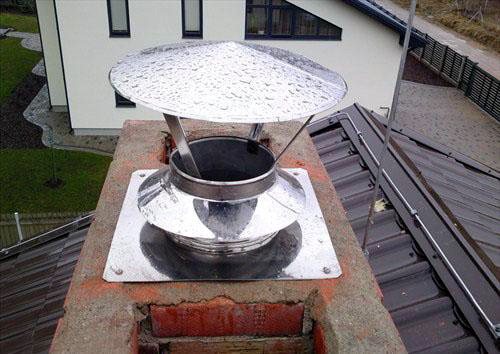

To carry out the installation and installation of the structure, you will need to take threaded rods and a piece of pipe with a diameter slightly larger than the dimensions of the smoke channel. Installation on a pipe is carried out according to the following scheme:
- Mark the places of future fasteners on the pipe (10-15 cm from the edge) and the diffuser.
- Drill holes in the details at the designated points, make sure they match by trying the elements to each other.
- Insert threaded rods through the holes and fix them with nuts on both sides on the diffuser and pipe. It is better to tighten the nuts at the same time so as not to bend the metal sheet.
- Lift the structure to the roof of the house, put the pipe on the chimney and fix it with clamps.
It is necessary to ensure that all parts of the structure are precisely connected to each other, without leaving gaps and cracks. To do this, you need to especially tightly secure the pipe with clamps, if possible, treat the joints with a sealant.
Installing a weather vane on a chimney with your own hands is somewhat more difficult than installing a stable structure of a conventional diffuser. Holes are drilled in the chimney masonry to fix the lower cylinder of the weather vane. It is secured with bolts. It is very important to select the model of the weather vane in exact accordance with the diameter of the chimney. The installation features also consist in the fact that the structure must be fixed on the rotating axis of the weather vane.
Do-it-yourself tsagi deflector
| Author | Share | Rate |
| Victor Samolin |
Interesting on the topic:
The principle of operation and manufacture of ventilation deflectors
What exhaust technology to choose for your home
Three main technologies for installing a kitchen hood
Comments on this article
Sanya Kalyuzhny, Kharkiv thanks, I will make a deflector
09/18/2015 at 17:27KasparSn Thanks for the dimensions shown! The deflector for these coefficients turned out to be excellent, copes with its task without any complaints. 02/05/2016 at 15:59
Jordanbowl I made a cardboard deflector according to your plate. Everything worked out. It remains only to repeat on a stainless steel sheet. 04/13/2016 at 11:36
Arthur Now we are using a chimney without a nozzle. Is there any data on how much the efficiency of the thermal device will increase when installing the deflector? 05/10/2016 at 23:33
Gorin Hello! If you choose the right size and type of deflector, then the efficiency of the heating unit increases by about 20%. But this is not the only benefit, since the deflector still serves as protection against the ingress of precipitation and debris into the chimney. 05/11/2016 at 17:35
Chimney deflector installation
The deflector must be selected based on the parameters of the pipe. Some structures are attached to the top of the chimney. There are models of deflectors in which the cylinder diameter must coincide with the outlet pipe mouth.
The diameter of the deflector is usually from 10 to 50 cm. The width of the diffuser of models can vary from 24 to 100 cm. The height of the deflector can reach from 14 to 60 cm.
When installing the deflector on the chimney, you must be guided by the following rules:
- Depending on the type of roof, the installation method of the flue must be different. On a flat roof, the chimney should extend beyond the fence. On the pitched type, the mouth of the pipe should be located above the ridge if there is less than 1.5 meters between them. If more, the outlet is at the same level as the ridge.
- The installation of a cylindrical deflector on a brick chimney has features. It is necessary to use transition pipes, otherwise there will be no required thrust.
- The deflector must be blown from all sides. Avoid installing the device if it is partially obscured from the wind by an adjacent building.
- The type of deflector should be selected according to the area on which the building is located. If the structure is located on a vacant lot, where there are very strong air currents, it is advisable to install the most powerful types of deflectors. These include H-shaped devices.In climates with harsh winters, it is advisable to refrain from installing a rotating deflector, as it can freeze up.
You can fix the deflector to the chimney using various materials:
- tie-ins on the deflector itself;
- bolts;
- brackets;
- clamps.
Often, a sealing strip is used with these fasteners to better adhere the two surfaces.

